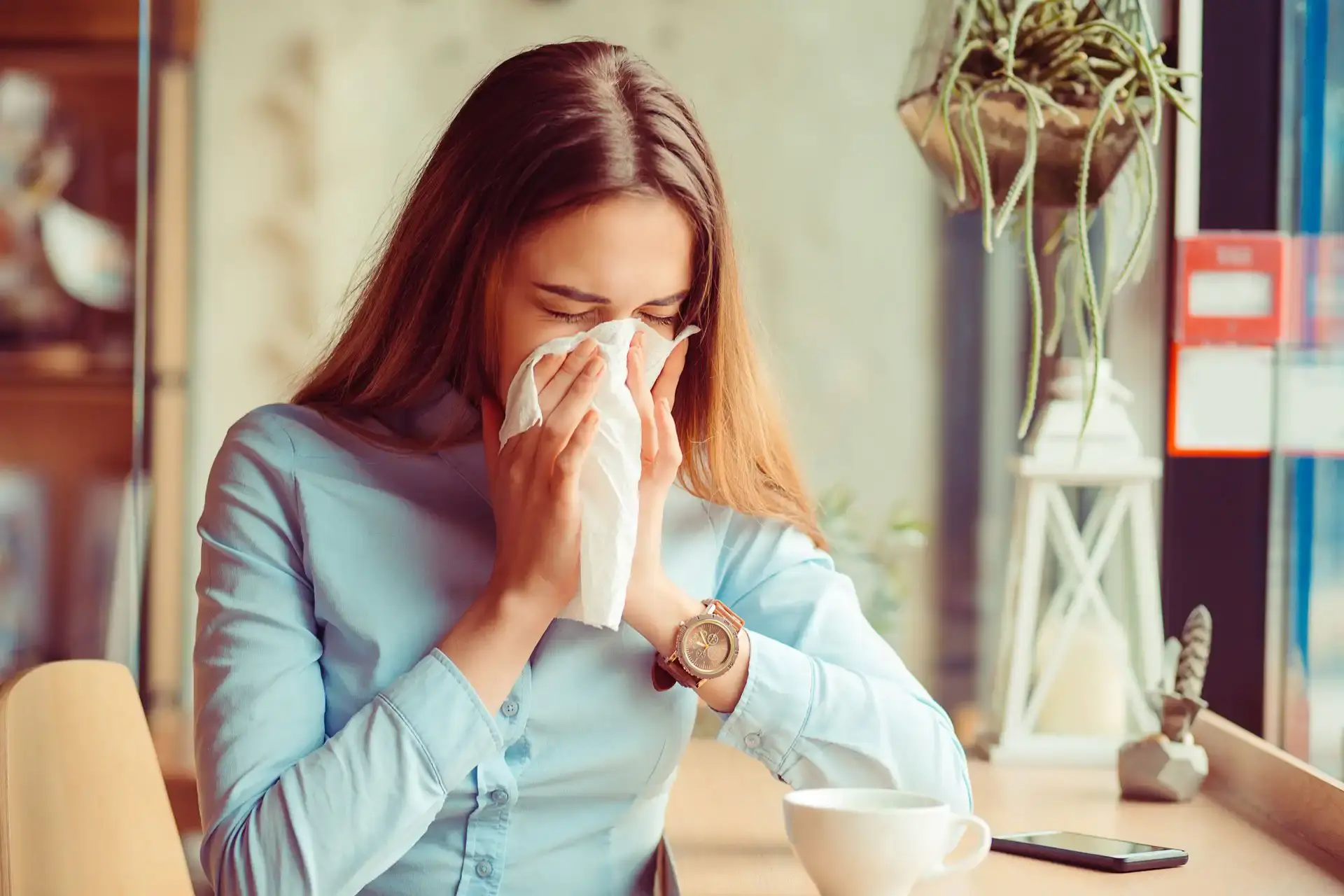Our four-legged furry friends make great company, but if you have cat or dog allergies you may think otherwise. These allergies are more common than you think — it’s estimated that around 30% of people in the United States have pet allergies.1
Pet allergies, often triggered by pet dander and saliva, are largely indoor allergies that can occur any time of year. In this article, we’ll discuss what causes pet allergies, their symptoms, and tips and tricks to help keep them to a minimum in your home.
What Causes Dog and Cat Allergies?
The most common causes of pet allergies are dander, saliva, and urine, which can trigger a histamine response in some people. Dander can be found in the air, or on surfaces like upholstered furniture and carpets. It can also stick to hard surfaces like walls and floors. Interestingly, you can still experience allergy symptoms even if you’re not in the same room as a pet. For example, just being near someone who has a pet may be enough to set off your allergies.2
Pet fur can also harbor other allergens, like dust and pollen, especially on animals that are often outside. If you’re allergic to these as well as dander, your allergies may be worse.2
It is also possible to be allergic to dog saliva. If a pet licks you, it may cause your skin to become red and swollen. Some people may also have an allergic reaction to a cat scratch, causing the same symptoms.2
What Is Pet Dander?
You’ve likely heard the term, but you may be wondering, what is pet dander? Dander is made of dead skin flakes that are shed from a pet. If these flakes are inhaled or make contact with your skin, you may have an allergic reaction.2
It’s important to note that, contrary to popular belief, pet fur and hair are not the main cause of allergic reactions to pets — instead, it’s the dander that causes most people’s pet allergies.2
Other Pets That Can Cause Allergies
When you think of pet allergies, you most likely think of cats and dogs. However, any mammal — such as rabbits, guinea pigs, and hamsters — can shed dander and trigger allergies. Animals that do not shed dander, such as reptiles, fish and amphibians, may also trigger allergies.
Symptoms of Being Allergic to Cats, Dogs, and Other Pets
Pet allergy symptoms are similar to other kinds of allergy symptoms. The severity of these will depend on how allergic you are. Common dog and cat allergy symptoms include:4
Runny or stuffy nose, sneezing — May develop after being exposed to dander (inhaling it)
Itchy, red, or watery eyes — Allergic conjunctivitis can occur after touching a pet and then rubbing your eyes
Facial pain — Can be caused by nasal congestion
When To See a Doctor for Pet Allergy Symptoms
If you’re unsure about whether you have pet allergies, or you have severe symptoms and reactions around pets, consider visiting your doctor. They can refer you to an allergist, who will perform a physical examination and allergy testing.4
The allergist will likely perform a skin-prick test to determine if you have allergies. They will place small droplets of extract containing different pet allergens on your skin, then prick it with a small, sterile probe. This allows the extract to enter your skin to see if an allergic reaction occurs. If you develop redness or swelling where a certain allergen was placed, you’re likely allergic to it.4
How To Manage and Treat Dog or Cat Allergies
If you are allergic to cats, dogs, or other pets, it’s important to limit your exposure to pet dander and other pet allergy triggers as much as possible to manage your symptoms. Try these tips to make life with your four-legged friends more harmonious.
Clean Your Home Regularly to Get Rid of Pet Dander
Pet dander and other pet allergens can stick around for a long time, even after pets are gone. With this, it’s best to deep clean your house often. This can include dusting and wiping down surfaces with a damp cloth and vacuuming. Wash bedding and blankets in hot water with detergent, then dry on high heat to help remove dander.2 Cleaning bedding regularly may also help improve other allergy symptoms that get worse at night.
Find additional tips for combatting other indoor allergens here.
Choose Pets Wisely to Prevent Pet Allergies
If you’re looking for an allergy-friendly pet, you may want to consider animals that do not shed dander. These include fish, reptiles, and amphibians.3
If you still want a dog, consider getting a “hypoallergenic” one. The American Kennel Club (AKC) states that no dog breed is 100% hypoallergenic, but certain ones are better for people with pet allergies than others. Examples include schnauzers and poodles. You may still experience some allergy symptoms around these breeds, but it’s likely to be less compared to others.1 Learn more about hypoallergenic pets.
Keep Pets Off Beds and Couches to Control Dander Spread
Pet dander can get buried deep into upholstered or fabric-covered surfaces, which is difficult to remove. Try to keep pets off of couches, chairs, and beds to limit the spread of dander. Limiting your pets to certain rooms in the house that do not have this furniture or carpeting can also help.2
Use an Air Purifier to Filter Airborne Pet Allergens
To help keep dander out of the air, use an air purifier with a high-efficiency particulate air (HEPA) filter to clean the air in your house. Using the purifier just four hours a day can help limit dander. Unfortunately, these purifiers do not help remove dander stuck to surfaces, so be sure to clean regularly as well.2
Immunotherapy for Pet Allergies
Immunotherapy is a type of treatment provided by an allergist that trains your immune system to become more tolerant of allergens. There are two main types of immunotherapy for treating allergies — allergy shots and sublingual immunotherapy (SLIT).5
Allergy shots are given once or twice per week for four to six months, with the dosing of the allergen increasing over time. Eventually, your immune system will not react as strongly, resulting in fewer symptoms. You’ll need maintenance shots every four weeks for up to five years to keep your body accustomed to the allergen. If you’re interested in learning more about immunotherapy, talk to an allergist.6
Nasal Irrigation to Remove Pet Dander
Nasal irrigation can help wash out the nose and sinuses to clear away irritating allergens, like pet dander. Use a squeeze bottle or neti pot with sterile saline solution to flush out your nose. Be sure to rinse the device after each use and let it air-dry to prevent bacterial growth.6
Use BENADRYL® to Combat Pet Allergy Symptoms
If you’re looking to treat cat and dog allergy symptoms at the source, try BENADRYL® products, such as BENADRYL® Allergy ULTRATABS® for temporary relief. Along with the above-listed tips and tricks, you can keep your pets around while kicking allergies to the curb.
References
Cleveland Clinic Health Essentials. Are Any Dog Breeds Hypoallergenic? January 22, 2021. Accessed from: https://health.clevelandclinic.org/are-any-dogs-hypoallergenic/
Asthma and Allergy Foundation of America. Pet Allergy: Are You Allergic to Dogs or Cats? October 2015. Accessed from: https://www.aafa.org/pet-dog-cat-allergies/
American Lung Association. Pet Dander. February 8, 2022. Accessed from: https://www.lung.org/clean-air/at-home/indoor-air-pollutants/pet-dander
American College of Allergy, Asthma, & Immunology. Pet Allergies. April 23, 2018. Accessed from: https://acaai.org/allergies/allergic-conditions/pet-allergies/
American College of Allergy, Asthma, & Immunology. Allergy Immunotherapy. Accessed from: https://acaai.org/allergies/management-treatment/allergy-immunotherapy/
Mayo Clinic. Pet allergy. August 4, 2021. Accessed from: https://www.mayoclinic.org/diseases-conditions/pet-allergy/diagnosis-treatment/drc-20352198


